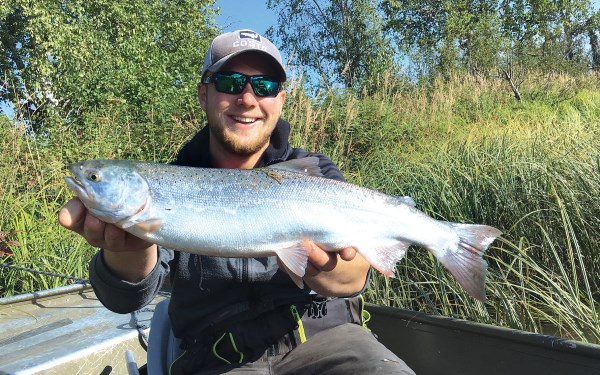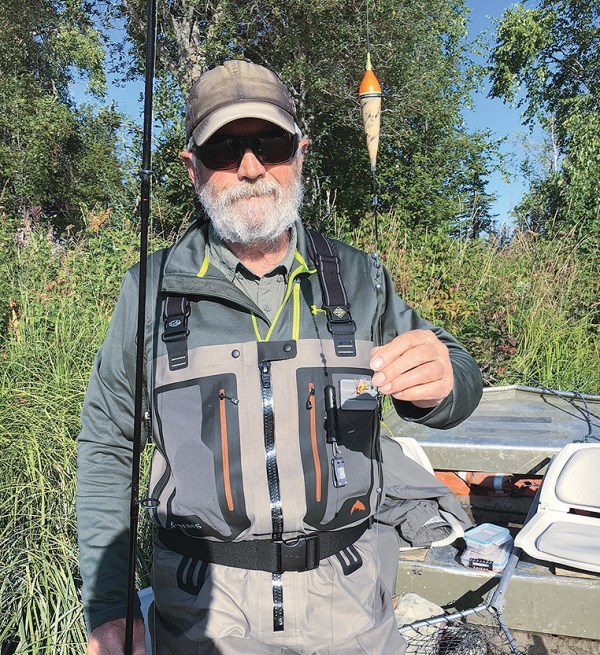
I’d booked a short three day trip to Riversong Lodge, on the Yentna River, 70 air miles north west of Anchorage. Thanks to the vagaries of Alaskan weather, it had already become a two and a half day trip before the Beaver floatplane had even left Anchorage.
It was advertised as a wilderness experience— there is no road access and the only way in is to fly, land by a sandbank opposite the lodge and be picked up by one of the lodge boats— but I counted at least six other lodges in close proximity. It also advertised great salmon, rainbow trout and grayling fishing; it was for the rainbow trout and grayling I had chosen Riversong Lodge..
I learned shortly after arriving that the rainbow trout and grayling fishing was difficult, as the river was so low the guides could not get the boats far enough upstream to where the good fishing started.

So my guide, Daryl, asked if I would like to float fish for salmon—coarse fishing. I had centre-pin fished for salmon before in Canada, which involved sending a bait under a float downstream, using the strength of the water to pull line from the reel until either the float went under or it was out of sight. Then you reeled in and started again. This type of float fishing Daryl assured me was nothing like that. Much easier!
The Yentna River is a glacial river with a heavy silt load— put your hand in the water and before you get your wrist wet, you can not see your fingers—in spite of which it has an enormous run of all five pacific salmon, at different times of the year.
It was September, silver salmon time.
We motored down river to a place called Indian Pond, a backwater off the Yentna river. As we idled into the backwater, it looked like we had come to a parking lot for boats. Around the shoreline were moored about thirty boats, all nose into the shore and the sports sitting at the stern holding a rod. We put our nose into the bank and tied up to a convenient bush. Daryl then set up the rod: nine feet long with a fixed spool reel, loaded with 30 or 40lb line, a large float above enough weight to cock the float and a large glob of silver salmon eggs on a size 1/0 hook.
He explained that we were to take advantage of an evolutionary quirk of nature—hen silver salmon will eat the eggs of another silver salmon to increase the chances of her eggs hatching and most of the salmon being caught were females.
A huge pod of fish were swimming around the backwater—you could track their progress by the floats going down. Soon it was my turn. My float disappeared under water. I struck and was attached to a very lively salmon.
“Hold it, hold it,” advised Daryl. “Don’t let it run.”
The need for 30-40lb line became apparent, as I clamped down and let the rod fight the fish. If I had let the fish run, it would have collected the lines of other fisherman, creating one un-holy mess to clean up.
Sporting? I don’t think so. After several minutes Daryl netted the fish and brought it into the boat. I did not want any fish to take home but offered any to Daryl, so it got knocked on the head and slid into the fish-well on the boat.
Ten minutes later the pod of fish came around again and we repeated the above. Ten minutes after that the fish came round again and we did it all again.
None of the other boats were putting fish back—this was a pure meat hunt.
I’d had enough and suggested we try some flyfishing, so we untied and slipped away.
Twenty minutes up-river we turned into a clear water tributary with a fishing camp on one side. Past the camp, we dropped anchor and tried to catch salmon on fly rods. It should have been an ideal spot, as silvers like to pull out of the main current into slower water to rest before continuing the rush up-steam to spawn, but we were fishless after an hour, so stowed the rods to return to camp. Daryl reversed the boat to free the anchor and the motor died.
He took the cover off the outboard motor and went looking for the problem. Drifting back towards the Yentna River, we were hailed by a guy from the camp asking if we needed a hand. I lay on the bow and hand paddled us close enough to throw him a rope.
Pulled to the shore I did the most useful thing I could do, which was stay out of the way while they explored the inner workings of the motor. They eventually determined that a part had broken and if they attached this to that, we should get back to the lodge.
Firing up the engine after the fix, we surged forward into the Yentna—only to have the motor cut out again. Daryl restarted it immediately but we had lost forward. Slamming it into reverse, we had power just above idle—enough to move the boat. So we pointed the stern up-stream and puttered across the mile wide river.
I then noticed we did not have any oars and no cell phone coverage. Alone on a swift river going backwards against the current.
Suddenly this was no longer fun!
Daryl explained he was aiming to get far enough across for the river to take us between the sandbank and the camp. The only minor obstacle was the dead trees and brush we had to navigate without getting stuck or worse in.
We arrived at the point of the sand bank and hit the trees, thankfully a glancing blow, which spun us around but left us floating backwards down the channel. One of the other guides put his head over the bank and helped us pull into the camp boat dock.
The only comment I got from the staff at the lodge was that I was late for lunch!!!













